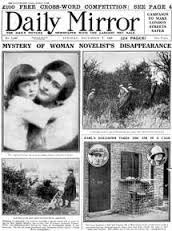15th September 1890. Queens of Crime.
Detection a species of popular fiction bears the same relation to actual crime as pastoral poetry to the realities of rural economy, said Micheal Innes, one of many male, crime writers who over the years have included Edgar Wallace and Carter Dickson, but it is Agatha Christie, of the old traditional writers of the genre who maintains her popularity.
Born Today in 1890 to wealthy parents in Torquay this gave Christie time to indulge her fancy for crime, represented by her eighty novels, short story collections and plays, surpassed in sales only by the Bible and Shakespeare, by selling four million books world wide every year.
She was thus set to become the ‘Queen of Crime’, but in 1926 became the subject of a mystery herself by disappearing, only to be tracked down at a Harrogate hotel after a maid identified a newspaper picture.
The cause appears to resulted from domestic problems with her husband Colonel Christie from whom she separated, later to marry the archaeologist Sir Arthur Mallowan, who was to be the inspiration for many of her plots.
Many find her characters are pale and lacking in depth and emotion, used as pawns to be moved to her purposes, her plots artificial and her prose flat and superficial. Many early books were xenophobic and anti-Semitic and unfeeling, but she was a creature of her time.
In the The Girdle of Hyppolita’ 1939) we read, ‘Those miserable idiots of the unemployed’, then her maids are usually stupid with adenoids, whilst murder was regarded as a mere parlour game.
Christie emerged as a crime writer alongside three other women, in a golden-age for crime fiction, which included Dorothy L. Sayers (born 1893) and Ngaio Marsh (born 1895).(1)
The third Margery Allingham (born 1904) was married to Peter Youngman-Carter who finished her last book ‘Cargo of Eagles’, after her death, but is better known as the illustrator of many of the crime novel, dust-covers of the era.
One thing all these writers had in common was that they were leisured girls, who starting writing to restore family finances, but it was a genre which created memorable and legendary private investigators such as Christie’s Hercule Poirot who was obsessed with Motivation to solve the crime.
The Belgian refugee and egg-headed, Poirot, dapper and pernickety in appearance and behaviour yearned to retire to cultivate vegetable marrows, in the early novel the Murder of Roger Akroyd, and made his appearance in her first book, The Mysterious Affair at Styles (1920).(2)
Sayers’ Lord Wimsey stressing the notion of ‘How’ a crime was committed to track down its perpetrator, was loosely based on friends she had met at Somerville College and later, and Bunter his manservant was also based on a friend’s gentleman’s gentleman. He and Allingham’s Albert Campion and Marsh’s Roderick Alleyn were to map out a new direction for English murder mysteries.
But then came a lady, in Christie’s fluffy, Miss Marple of St. Mary Mead making her main entry in 1930 in Murder at the Vicarage where she is described as ‘that terrible Miss Marple’, however when she appeared in the 1942 Body in the Library she had mellowed into; ‘a fluttering fluffiness and clouds of knitting wool, living in the evocative generic village, and rigid in pursuit of truth and justice, untroubled by pity’.
Marple was based on Christie’s Granny and her elderly lady visitors in Ealing, London.(3)
(1) Sayers was one of the volunteers who helped to search Newland’s Corner the remote Surrey beauty spot where Christie’s car was found, after her disappearance.
(2) The publishers Hodder and Stoughton sent it back as did Methuen and finally it was John Lane at the Bodley Head who published it two years later.
(3) The Marple name was taken from the now demolished Marple Hall in Cheshire and is the most famous old lady in literature, since Dickens’ Miss Haversham, after making a discreet appearance in a 1927 magazine story. It was at this time when investigator Miss Climpson appeared in Sayer’s ‘Unnatural Death‘.
References:
Daily Herald 15.12.1926. Article on Disappearance.
flavorwire/Pic A murder is Announced.
Daily Mirror December 1926.
loyal books/Pic/ Whose Body?
vulpeslibres.word press.com/Pic/9 Tailors.





